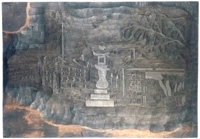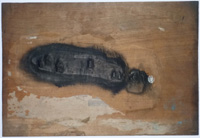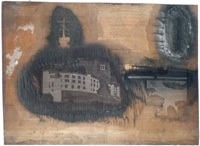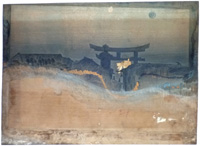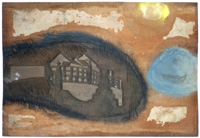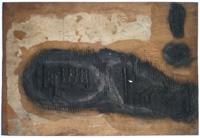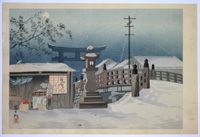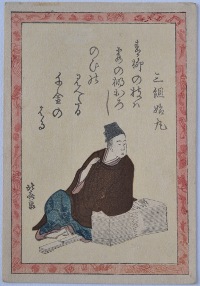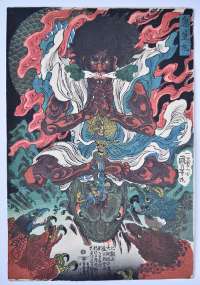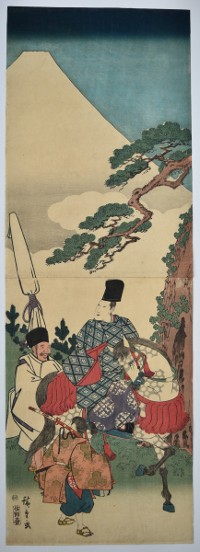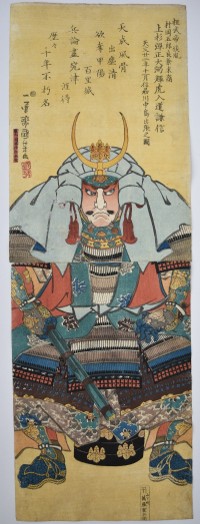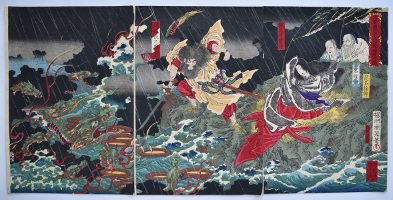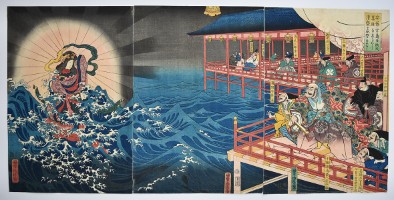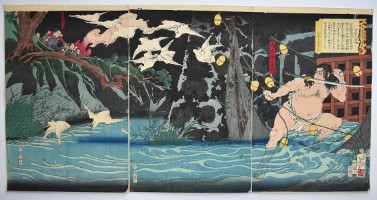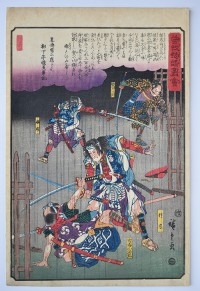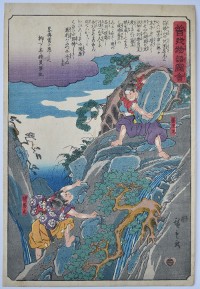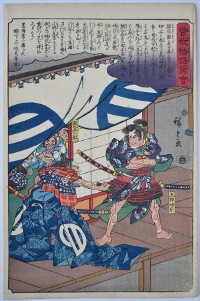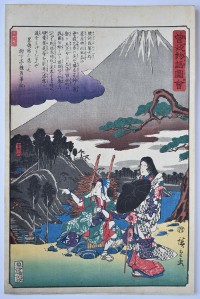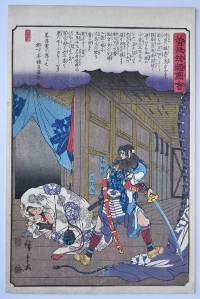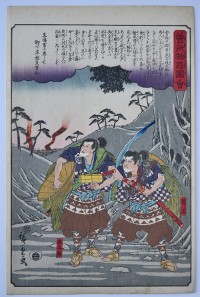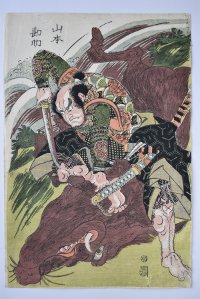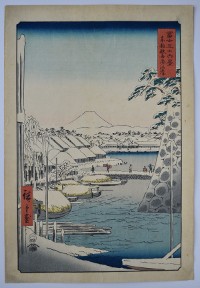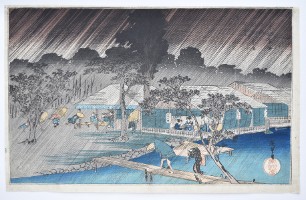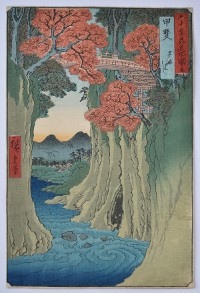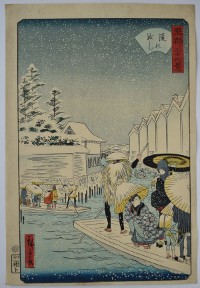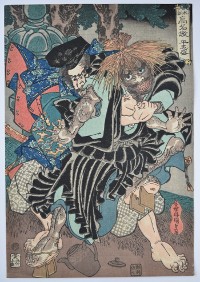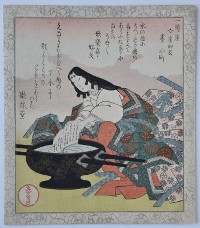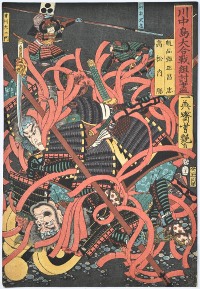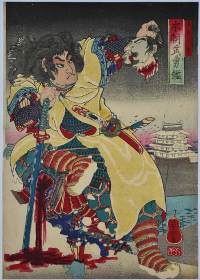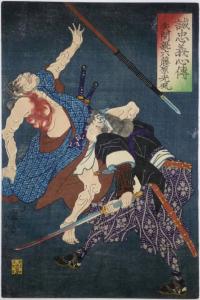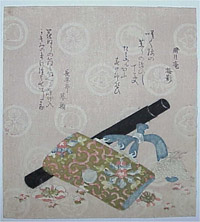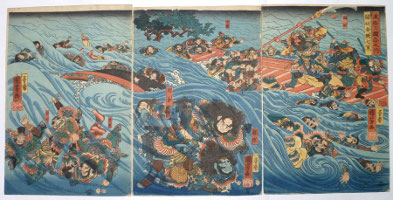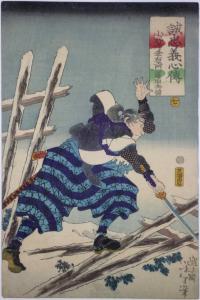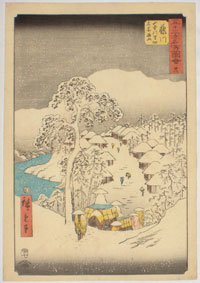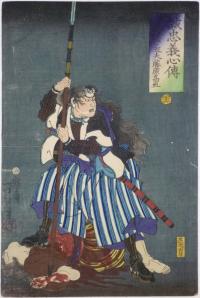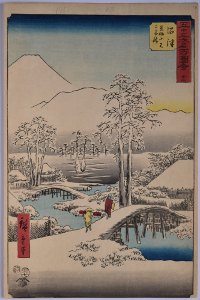/category/archive/page/11/
Tomikichiro TOKURIKI (1902-2000)
Click here to view image full size.
A complete set of 5 double-sided original woodblocks comprising the keyblock and 9 colour blocks. Sold together with the finished print. Although late, it’s very rare to find complete sets of blocks and shows clearly how the prints were produced. Some of the blocks retain the keyblock proofs glued to them. For print 11, Kameyama Shrine in Kishu from a set of 50 prints of scenes of sacred places and historic landmarks. Published by Uchida Bijutsu Shoten, 1941. The average size of blocks is 11.75 x 17 in; 30 x 43 cms. All blocks sold “as is.” The print is in good condition.
Status: Sold
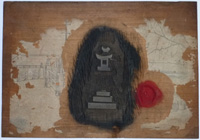
Click here to view image full size.
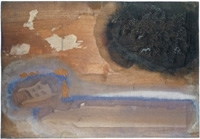
Click here to view image full size.
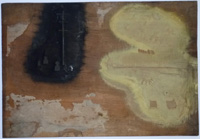
Click here to view image full size.
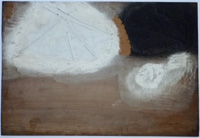
Click here to view image full size.
Yashima GAKUTEI (1786?-1868)
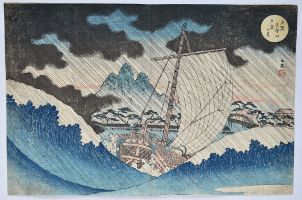
Click here to view image full size.
A sailing junk caught in stormy seas, driving rain, and under a threatening sky. The masterpiece from a set of six prints issued in album form with title Naniwa meisho, Tempozan shokei ichiran, “A Famous Place in Osaka, Selected Views of Mount Tempo.” Published in Osaka, 1834, by Shioya Kisuke. In the circular cartouche: Osaka Tempozan yudachi no kei, “View of a Storm at Tempozan, Osaka.”Gakutei is best known for his many surimono. He was also a kyoka poet and painter. Unfortunately he produced few landscapes. Other impressions illustrated in Michener, Japanese Prints, no. 198; Mellor sale catalogue, Sotheby, July 1963, pl. XXXI; and Grabhorn, Landscape Prints of Old Japan, pl. 30. SC I/344. One of the great 19th century landscapes.
Fine impression. Very good colour. Slight trimming at bottom and backed centre fold (as usual as it was published in folding album form), otherwise good condition. Signed Gogaku with seal Go.
Status: Sold
Katsushika HOKUSAI (1760-1849)
Click here to view image full size.
A koban surimono from a kyoka set ( of one hundred ? ) published c. 1805. Shows a kyoka poet with poem by Mikumi Himemari. Seemingly the only large group illustrated is in the Katsushika Hokusai Exhibition from The Peter Morse Collection, Ukiyo-e Ota Memorial Museum of Art, 1988, no . 167 ( this design on page 106 ). Rare. Ex collection Tony Strauss-Negbaur ( seal au verso ).
Fine impression, colour and condition. Signed Hokusai ga.
Status: Sold
Utagawa KUNIYOSHI (1797-1861)
Click here to view image full size.
Kido Maru learning magic from the forest tengu. Possibly Kuniyoshi’s greatest design in this genre. He is shown, cross-legged,atop a giant python, two wrapped pine sprigs (aomatsuba) in his mouth. A long dagger is driven into the python’s head and snakes curl around its blade. Robinson SIF.1. Illustrated in colour , pl. 12, and also used on the front cover of B. W. Robinson, Kuniyoshi: The Warrior-Prints, Phaidon, 1982. This is the rare first edition published by Tsutaya Kichizo, c 1840 with the kiwame seal above publisher.
Very fine impression with fine gradation (missing later on). Fine colour. Imperceptible fold, otherwise fine condition. Full size. Signed Ichiyusai Kuniyoshi ga.
Status: Sold
Ichiryusai HIROSHIGE (1797-1858)
Click here to view image full size.
A vertical diptych showing the famous poet and court noble, Ariwara no Narihira (825-880), on horseback with his attendant before Mt. Fuji on their way to the east. The eastern journey was one of the main parts of the Ise Monogatari. Published by Marukyu, c 1845-6.
Fine impression, colour and condition. Full size with ample room for joining. This is the best copy of this design I have seen. Signed Hiroshige ga.
Status: Sold
Utagawa KUNIYOSHI (1797-1861)
Click here to view image full size.
A rare vertical diptych showing the famous Daimyo Uesugi Kenshin (1530-1578). He ruled Echigo Province and was known as a skillful administrator as well as warlord; also for his rivalry with Takeda Shingen who he fought at the fourth battle of Kawanakajima. Published by Jubei Yorozuya, 1846.
Fine impression and colour. Extensive mica applied to the headgear. Yellow ground. Very slight trimmimg at bottom, otherwise full size with ample room for joining. Signed Ichiyusai Kuniyoshi ga.
Status: Sold
Toyohara CHIKANOBU (1838-1912)
Click here to view image full size.
A triptych showing the Shinto Storm God Susanoo about to slay the eight-headed dragon, Yamata no Orochi, at the head of the Hi river in pouring rain. The dragon devoured virgins and had eaten the seven daughters of two earthly deities, seen top right. The eighth, Kushi-inada-hime, also on right, is saved by Susanoo who encourages the dragon to drink eight times brewed sake from eight vats which intoxicates it enough to be killed. Rare: Chikanobu is not known for this type of subject. Published c 1870s.
Very good impression, colour and condition. Mica applied to sky, rain printed in silver. Full size. Signed Yoshu Chikanobu hitsu.
Status: Sold
Utagawa YOSHITORA (Active c 1850-1880)
Click here to view image full size.
The Dragon Princess rising from the sea to the amazement of Taira no Kiyomori (1118-1181) and his court. Published by Enshuya Hikobei, 1861.
Fine impression and colour. Very slightly trimmed, otherwise fine condition. Signed Yoshitora ga.
Status: Sold
Tsukioka YOSHITOSHI (1839-1892)
Click here to view image full size.
A triptych showing a scene during the siege of Nagashino Castle by Takeda Katsuyori. Torii Suneemon Katsutaka was sent to get help and managed to evade the guards. He insists on returning to his comrades but meanwhile Takeda has fastened bells to the cables on the castle’s exit which gave the alarm and frightens a flock of herons. Katsutaka was captured and died a samurai’s death shouting hold fast to his comrades. Takeda’s troops were subsequently massacred. Published by Kinseido, 1868. From a series Bidan musha hakkei, “Eight Views from Fine Tales of Warriors.”
Very fine impression, the rain beautifully burnished; blind-printing and mica applied. Fine colour and condition. Full size. A fine copy. Signed Tsukioka Yoshitoshi hitsu.
Status: Sold
Ichiryusai HIROSHIGE (1797-1858)
Click here to view image full size.
The brothers Goro and Juro battling Kikko Kojiro and Aiko Saburo in the pouring rain. From a set Soga monogatari zue, “The Revenge of the Soga Brothers.” A set of 30 prints published by Ibaya Senzaburo, 1848. This famous story has many versions but basically it tells how Kawazu Sukeyasu was murdered by his cousin Kudo Suketsune. Sukeyasu left two sons and his widow remarried a man called Soga. He adopted the two children and they waited patiently for an opportunity to kill Suketsune which came when he was hunting near Mt. Fuji. They killed him but were themselves slain in the ensuing battle. This is the first edition, it was republished in 1858 by Yamaguchiya Tobei.
Fine impression and colour. Light album backing, otherwise fine condition. Signed Hiroshige ga.
Status: Sold
Ichiryusai HIROSHIGE (1797-1858)
Click here to view image full size.
Hakomaru (Soga no Goro) stands on top of a steep cliff holding a huge boulder. From a set Soga monogatari zue, “The Revenge of the Soga Brothers.” A set of 30 prints published by Ibaya Senzaburo, 1848. This famous story has many versions but basically it tells how Kawazu Sukeyasu was murdered by his cousin Kudo Suketsune. Sukeyasu left two sons and his widow remarried a man called Soga. He adopted the two children and they waited patiently for an opportunity to kill Suketsune which came when he was hunting near Mt. Fuji. They killed him but were themselves slain in the ensuing battle. This is the first edition, it was republished in 1858 by Yamaguchiya Tobei.
Fine impression and colour. Light album backing, otherwise fine condition. Signed Hiroshige ga.
Status: Sold
Ichiryusai HIROSHIGE (1797-1858)
Click here to view image full size.
Asahina Saburo tugging on Goro Tokimune’s armour. From a set Soga monogatari zue, “The Revenge of the Soga Brothers.” A set of 30 prints published by Ibaya Senzaburo, 1848. This famous story has many versions but basically it tells how Kawazu Sukeyasu was murdered by his cousin Kudo Suketsune. Sukeyasu left two sons and his widow remarried a man called Soga. He adopted the two children and they waited patiently for an opportunity to kill Suketsune which came when he was hunting near Mt. Fuji. They killed him but were themselves slain in the ensuing battle. This is the first edition, it was republished in 1858 by Yamaguchiya Tobei.
Fine impression and colour. Light album backing, otherwise fine condition. Signed Hiroshige ga.
Status: Sold
Ichiryusai HIROSHIGE (1797-1858)
Click here to view image full size.
A noblewoman is directed to the Soga shrine by a wood-gatherer. From a set Soga monogatari zue, “The Revenge of the Soga Brothers.” A set of 30 prints published by Ibaya Senzaburo, 1848. This famous story has many versions but basically it tells how Kawazu Sukeyasu was murdered by his cousin Kudo Suketsune. Sukeyasu left two sons and his widow remarried a man called Soga. He adopted the two children and they waited patiently for an opportunity to kill Suketsune which came when he was hunting near Mt. Fuji. They killed him but were themselves slain in the ensuing battle. This is the first edition, it was republished in 1858 by Yamaguchiya Tobei.
Fine impression and colour. Light album backing, otherwise fine condition. Signed Hiroshige ga.
Status: Sold
Ichiryusai HIROSHIGE (1797-1858)
Click here to view image full size.
Goro Tokimune comes across the wrestler Goromaru. From a set Soga monogatari zue, “The Revenge of the Soga Brothers.” A set of 30 prints published by Ibaya Senzaburo, 1848. This famous story has many versions but basically it tells how Kawazu Sukeyasu was murdered by his cousin Kudo Suketsune. Sukeyasu left two sons and his widow remarried a man called Soga. He adopted the two children and they waited patiently for an opportunity to kill Suketsune which came when he was hunting near Mt. Fuji. They killed him but were themselves slain in the ensuing battle. This is the first edition, it was republished in 1858 by Yamaguchiya Tobei.
Fine impression and colour. Light album backing, otherwise fine condition. Signed Hiroshige ga.
Status: Sold
Ichiryusai HIROSHIGE (1797-1858)
Click here to view image full size.
Onio and Dozaburo, the retainers of the Soga Brothers. From a set Soga monogatari zue, “The Revenge of the Soga Brothers.” A set of 30 prints published by Ibaya Senzaburo, 1848. This famous story has many versions but basically it tells how Kawazu Sukeyasu was murdered by his cousin Kudo Suketsune. Sukeyasu left two sons and his widow remarried a man called Soga. He adopted the two children and they waited patiently for an opportunity to kill Suketsune which came when he was hunting near Mt. Fuji. They killed him but were themselves slain in the ensuing battle. This is the first edition, it was republished in 1858 by Yamaguchiya Tobei.
Fine impression and colour. Light album backing, otherwise fine condition. Signed Hiroshige ga.
Status: Sold
Katsukawa SHUNTEI (1770-1820)
Click here to view image full size.
Yamamoto Kansuke (Haruyuki) (1501-1561) overpowering a gigantic boar. Takeda Shingen’s most valuable general and one of the Takeda nijushi-sho, “Takeda’s Twenty-four [most trusted] Generals.” Kansuke was involved in a lengthy feud with Kenshin Tora and is killed in one of their skirmishes at Kawanakajima on 12 Oct. 1561.
Very good impression, colour and condition. Signed Shuntei ga.
Status: Sold
Ichiryusai HIROSHIGE (1797-1858)
Click here to view image full size.
Sukiya embankment in snow, Toto Sukiya-gashi, from Fuji sanjurokkei, the “Thirty-six Views of Fuji.” The set published by Tsutaya Kichizo, 1858. The rampart on the inner side of the moat of Edo Castle on the right. Figures cross a bridge leading to Sukiya Gate. In the distance the long outer walls of the main residence of the Nabeshima Clan of Saga. Fuji on horizon.
Fine impression, very good colour and condition. Signed Hiroshige ga.
Status: Sold
Ichiryusai HIROSHIGE (1797-1858)
Click here to view image full size.
Tadasugawara no yudachi, “Evening Shower on the Bank of the Tadasu River” from the early set Kyoto meisho no uchi, “Famous Views of Kyoto.” The set of ten masterpieces was published by Eisendo, c 1834. Shows figures running in the rain to get to the tea-houses which lined the banks here where the Kamo River and Takamo River joined.
Very good impression. The extremely rare first state of this print has the publisher’s seal in red in the upper left margin. This early state has the kiwame seal in the left margin. This was removed on later editions and the seal after Hiroshige’s signature has the characters reversed white on red. Very good colour. Imperceptible centre fold and trimmed close at top, otherwise very good condition. Signed Hiroshige ga.
Status: Sold
Ichiryusai HIROSHIGE (1797-1858)
Click here to view image full size.
The cantilevered Monkey Bridge from Rokujuyoshu meisho zue, “Famous Views in the Sixty-odd Provinces.” Published by Koshimuraya Heisuke 1853-6 (this being 1853). This bridge – one of the three most famous bridges in Japan – is situated in Otsuki and purports to be 1300 years old (albeit rebuilt many times).
Fine impression of the first edition. Fine colour. Trimmed close, otherwise very good condition. Signed Hiroshige ga.
Status: Sold
Utagawa HIROSHIGE II (1826-1869)
Click here to view image full size.
Yoroi no watashi, “Yoroi Ferry” from the set Toto sanjurokkei, “Thirty-six Views of Edo.” Published by Ai-To, 1862. Shows the laden ferry crossing in heavy snow. The Koami-cho warehouses on the right.
Fine impression of the first edition. Fine colour and condition. Signed Hiroshige ga.
Status: Sold
Utagawa KUNISADA (1786-1865)
Click here to view image full size.
Taira no Tadamori (1096-1153) grappling with the oil thief from a set: Honcho komei kagami, “A Mirror of our Country’s Renowned Heroes.” Published by Joshuya Kinzi, c 1835. The story relates how the Emperor Shirakawa was perturbed by a monster in the precincts of the Mido Temple at night. The samurai Taira no Tadamori was ordered to kill the beast only to discover a harmless old monk who steals a little oil from the stone lanterns. Kunisada designed a number of sets like this around this date.
Fine impression and colour. Very slightly trimmed, otherwise very good condition. Signed Kochoro Kunisada ga.
Status: Sold
Yashima GAKUTEI (1786-1868)
Click here to view image full size.
A surimono from a fine set of eight prints: Ichiyoren bunbo shiyu, “Four Companions of the Writing Studio for the Ichiyo Circle.” Issued c 1827 for the Ichiyoren poetry club. The set alternates Chinese and Japanese subjects with the literati tradition of brush, ink, inkstone and paper. In this case: Sumo Komachi, “Ink and Komachi.” Ono no Komachi being the famous mid-ninth century poet and it shows her washing a poetry anthology which included a poem plagiarized by another poet who accused her of stealing it. The ink ran proving her innocence. Poems by Karakutei Kobun and Karindo.
Very fine impression with blind-printing, gold and silver. Fine colour. Slight crease, otherwise fine condition. Signed Gakutei.
Status: Sold
Ichieisai YOSHITSUYA ( 1822-1866 )
Click here to view image full size.
Takamatsu Naizen and Tateshina Danjo Masatada grappling during the Battle of Kawanakajima in the mid 16th century. They are heavily entwined in the red ribbons of the standards. Published by Tsujiokaya Bunsuke in 1857.
Fine impression and colour. Light album backing, otherwise very good condition. Signed Ichieisai Yoshitsuya.
Status: Sold
Mori YOSHIYUKI ( 1835-1879 )
Click here to view image full size.
Shows Hido Hachiro holding the decapitated head of an enemy from Honcho buyu kagami, “Mirror of our Country’s Military Elegance.” Yoshiyuki was a pupil of Yoshiume and designed the set A Hundred Views of Osaka. He moved to Tokyo in 1868. Published by Tsutaya, c 1868. Rare: The first time I have catalogued this set.
Fine impression, colour and condition. Signed Yoshiyuki ga.
Status: Sold
Tsukioka YOSHITOSHI (1839-1892)
Click here to view image full size.
The ronin Yazama Shinroku Fujiwara Mitsukaze ) from Seichu gishinden, “Tales of True Loyalty.” From a rare uncompleted set of the 47 Ronin published 6/1868 by Masudaya. Thirteen designs extant. It has been suggested that the set was completed but that the others are not known based on the fact that two of the prints are numbered 3 and 46. An error as artists did not commence and progress from number 1. Artists chose at random which numbers from a set to start with. Well known examples being Hiroshige’s Tokaido and Kisokaido.
Very good impression and colour. Small backed wormage and light album backing. Signed Ikkaisai Yoshitoshi hitsu.
Status: Sold
Anonymous (1821)
Click here to view image full size.
A still life from a set of six prints for the Iwagaki Club: Iwagaki-ren rokuhira no uchi. Shows a tobacco pouch, telescope and snake netsuke (for snake year 1821). There appear to be at least three states of this lovely surimono.
Fine impression and colour with gold and silver on the pouch. Minor rubbing, otherwise very good condition.
Status: Sold
Utagawa KUNIYOSHI (1798-1861)
Click here to view image full size.
Kwanyu ( Chin. Kwan Yu ), the celebrated warrior who was deified in 1591 as Kwan Ti, the God of War. Shows the warrior standing on a partially submerged boat, far right, with his long black beard and carrying a huge halberd overlooking the river battle with the Seven Armies of Gi ( Wei ). Published by Tsutaya Kichizo 1854.
Very good impression, colour and condition. Full size. Signed Ichiyusai Kuniyoshi ga.
Status: Sold
Ichiryusai HIROSHIGE (1797-1858)
Click here to view image full size.
A rare triptych showing fireworks over Ryogoku bridge with numerous pleasure boats negotiating the huge trestles of the bridge. A fine design published 1847 – 50 by Sanoki.
Very fine impression. Pristine colour and condition. Totally untrimmed and with deluxe double-printed red. Signed Hiroshige ga.
Status: Sold
Tsukioka YOSHITOSHI (1839-1892)
Click here to view image full size.
The ronin Okudera Kouemon Fujiwara Hidetomi ( number 7 ) from Seichu gishinden, “Tales of True Loyalty.” From a rare uncompleted set of the 47 Ronin published 6/1868 by Masudaya. Thirteen designs extant. It has been suggested that the set was completed but that the others are not known based on the fact that two of the prints are numbered 3 and 46. An error as artists did not commence and progress from number 1. Artists chose at random which numbers from a set to start with. Well known examples being Hiroshige’s Tokaido and Kisokaido.
Very good impression and colour. Light album backing. Signed Ikkaisai Yoshitoshi hitsu.
Status: Sold
Ichiryusai HIROSHIGE (1797-1858)
Click here to view image full size.
Fujikawa from the so-called “Upright Tokaido.” One of the two snow scenes from the set. Shows travelers coming and going at the edge of the village. Published by Tsutaya, Hare 7, 1855.
Very good impression with woodgrain evident in the sky. Very good condition with full margins. Signed Hiroshige ga.
Status: Sold
Tsukioka YOSHITOSHI (1839-1892)
Click here to view image full size.
The ronin Muramatsu Sandayu Fujiwara Takano ( number 46 ) from Seichu gishinden, “Tales of True Loyalty.” From a rare uncompleted set of the 47 Ronin published 6/1868 by Masudaya. Thirteen designs extant. It has been suggested that the set was completed but that the others are not known based on the fact that two of the prints are numbered 3 and 46. An error as artists did not commence and progress from number 1. Artists chose at random which numbers from a set to start with. Well known examples being Hiroshige’s Tokaido and Kisokaido.
Very good impression and colour. Small backed wormhole and light album backing. Signed Ikkaisai Yoshitoshi hitsu.
Status: Sold
Totoya HOKKEI (1780-1850)
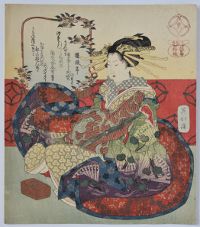
Click here to view image full size.
Originally a fishmonger (hence the go Totoya). Studied painting under Kano Yosen’in and then became one of Hokusai’s best pupils. Produced excellent surimono such as here showing a sumptuously attired courtesan representing Kyoto from a set of three surimono Sangoku-shi no toen ketsugi, a History of the Three Kingdoms. (A play on the Chinese states of Wei, Shu and Wu during AD 220-280, but here being Kyoto, Edo, Osaka.) Produced for the Shipporen (“Seven Treasures”) Kyoka Club c 1827. Their emblem top right and also incorporated into the background and on the box bottom left. Extremely rare.
Superb impression, colour and condition with extensive silver and gold. One of the finest surimono I have catalogued. Signed Go Hokkei.
Status: Sold
Yashima GAKUTEI (1786 [?]-1868)
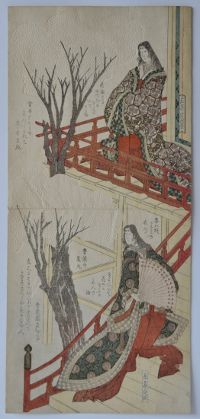
Click here to view image full size.
An uncut vertical surimono diptych showing two young women in court finery from the Heian period (794-1185). This being considered the finest and most cultured period in Japanese history. One stands on a balcony, the other on steps leading to the balcony overlooking a flowering cherry tree. Extremely rare: The separated design is in the MET, JP2062 and JP2061as well as them having an uncut example, JP1101. These vertical diptych designs were printed on a single sheet of hosho from a single block but with a horizontal crease between what would be the two separate surimono of conventional size. There are also two vertical diptych designs known which form a four surimono picture but these are even rarer.
Extremely fine impression, colour and condition. Extensive silver and blind-printing. Signed Gakutei Sadaoka hitsu and Gakutei Sadaoka.
Status: Sold
Utagawa KUNISADA (1786-1864)
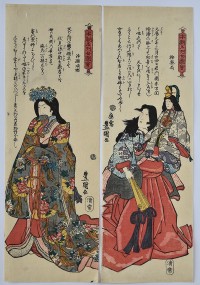
Click here to view image full size.
An extremely rare set of hosoban designs: Pictures of Various Women of imperial Japan. Shows, on the left, Princess Joruri – the lover of Yoshitsune. On the right Suke no Tsubone, the wet-nurse of the child Emperor Antoku who both drowned at the battle of Dan-no-ura in 1185. Published by Shimizuya Tsunejiro, 1845.
Very good impression and colour. Small repaired wormage on each sheet, otherwise very good condition. Signed Toyokuni ga.
Status: Sold
Ichiryusai HIROSHIGE (1797-1858)
Click here to view image full size.
Numazu from the Upright Tokaido, Gojusan tsugi meisho zue. Published by Tsutaya, 1855. The old adage that familiarity breeds contempt certainly applies to this set, which was reprinted many times. Early printings, as here, enable us to appreciate this underrated set. One of the two snow scenes from the set showing figures crossing one of two trestle bridges.
Very good to fine impression. The red cartouches double printed ( only seen on early impressions ). Fine colour. Light album backing and trimmed close at bottom right but leaving black border, otherwise very good condition. Signed Ichiryusai Hiroshige ga.
Status: Sold
Utagawa HIROSHIGE (1797-1858)
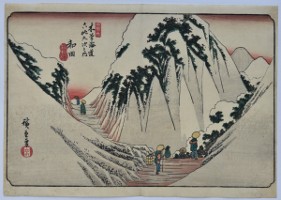
Click here to view image full size.
Shows station Wada in heavy snow from Kisokaido rokujukyutsugi no uchi. The set of seventy prints was started by Eisen and published by Hoeido in 1835, but in 1837 Hiroshige took over and completed the series with the publisher Iseya Rihei (Kinjudo). This high pass (1651 metres) was a difficult part of the journey.
Fine early impression before the break in the key block to the left and beneath the publisher’s gourd seal. Fine colour. Slight centre fold, otherwise very good condition. Signed Hiroshige ga.
Status: Sold
Utagawa TOYOHARU (1735-1814)
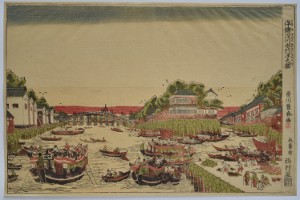
Click here to view image full size.
The founder of the Utagawa school who had, amongst others, Toyohiro and Toyokuni as his pupils. Although not the first to use western conventions of linear perspective, he was the first to employ them extensively and in full colour and had obviously studied engravings from Holland, Germany and Italy -particularly prints of Venice after Canaletto. Uki-e Fukagawa Eitai suzumi no zu, “Perspective Picture: A View Enjoying the Cool Near Eitai Bridge, Fukagawa.” Shows the Sumida River busy with boats; Eitai Bridge in the distance to the left and beyond the masts of vessels moored at Tsukudajima. (The Eitai Bridge was to collapse in 1807 killing anything from 500-1500 people.) To the right the then newly built neighbourhood of Nakazu. The water on the right is the Hakozaki canal. Published by Eijudo, c 1771. Provenance: Ex Hayashi collection, seal in right border. Extremely rare.
Fine impression and colour with the blue at the top intact which is very rare. In exceptional condition. Signed Utagawa Toyoharu ga.
Status: Sold
Ryuryukyo SHINSAI (c1764-1823)
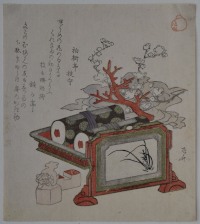
Click here to view image full size.
A surimono still life showing two handscrolls, a small screen, a branch of coral, a branch of plum blossom and two seals. (Coral and plum blossom are associated with the new year.) One of the seals has a tiger on top, possibly indicating this surimono was issued for the Tiger year 1818. From a series of still life surimono produced by the Taiko-gawa (Drum Poetry Group), their seal top right. Shinsai was one of Hokusai’s best pupils and is primarily known as a surimono designer. In fact, this surimono seems to have been reissued without the Drum seal and different poems. (See The Art of Surimono, Roger Keyes, Sotheby, 1985, no. 286, p. 334.) One poem by Rankotei Dondontei.
Very fine impression. Fine colour with gold and silver. Small crease top right and minor signs of mounting au verso, otherwise very good condition. Signed Shinsai.
Status: Sold
Utagawa HIROSHIGE III (1842-1894)
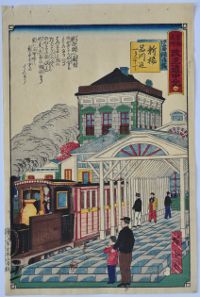
Click here to view image full size.
Shinbashi station from a set of prints Tokai meisho kaisei dochu-ki, “Newly Edited Travel Stories of Famous Places of the Tokaido.” Published by Shimizuya Naojiro, 1875. The station was opened in 1872.
Very good impression and colour. Binding holes in top border, otherwise very good condition. Signed Hiroshige ga.
Status: Sold
Utagawa HIROSHIGE III (1842-1894)
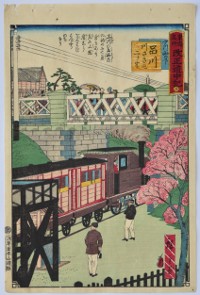
Click here to view image full size.
A train passing beneath a bridge at Shinagawa from a set of prints Tokai meisho kaisei dochu-ki, “Newly Edited Travel Stories of Famous Places of the Tokaido.” Published by Shimizuya Naojiro, 1875
Very good impression and colour. Binding holes in top border, otherwise very good condition. Signed Hiroshige ga.
Status: Sold
